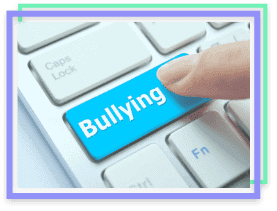Parents and teachers face a mounting problem they’ve never had before. Technology is rapidly evolving, and many of us feel that we can’t keep up to keep our kids safe online.
In addition to that, new online threats are constantly emerging. In addition to inappropriate content, evolving malware, and privacy threats, we should also protect our children from cyberbullying. An estimated one-third of young people have experienced cyberbullying, according to a study. And that’s only the cases that have been reported or found out. Many kids choose not to notify their parents when cyberbullying happens to them, which means the actual number of cyberbullying victims might actually be higher.
We know; cyberbullying is a tough challenge. And if you feel that you need more guidance, we’ll provide you a curated selection of organizations, podcasts, blogs, and books that can help.
What is Cyberbullying?
Cyberbullying is bullying that takes place over digital devices and it most commonly occurs over social media, text, instant messages and email. It can also happen through online gaming and forums. Cyberbullying can be particularly cruel and scary because it is done from behind a computer screen and often anonymously. Most young people do not believe social media platforms are doing enough to stop cyberbullying on their platforms.
Did You Know: According to our research on cyberbullying, it affects 34 percent of kids in the U.S. ages 10 to 18. Learn more cyberbullying statistics.

Examples of cyberbullying include:
- Sending hateful or threatening messages
- Sharing someone’s personal information or photos with others to embarrass
- Hacking into someone’s account and posting or sending messages as that person
- Posting mean and hurtful things publicly on social media
- Creating false social media profiles to hurt someone’s reputation

How can I educate myself
and my child or student?
We’ve put together a guide for parents and teachers who want to learn more about how to prevent, spot, and respond to cyberbullying among kids and teens.
 Organizations that can help
Organizations that can help
There are a large number of organizations out there sharing information around cyberbullying. The websites below are creating and sharing useful content that is truly helpful to anyone anxious about or experiencing cyberbullying.
Stopbullying.gov is the official government website of the United States aimed at preparing families and caregivers to prevent, address, and stop bullying issues. While this website focuses on all types of bullying, it contains a wealth of resources about cyberbullying. It has a blog, social media pages, and a YouTube channel. There are also printable and shareable resources available for parents and teachers alike. Stopbullying.org has a section specifically for cyberbullying that includes:
- Tips on prevention
- Warning signs
- Rules to establish
- Tips for educators
- Ways to get help
Cyberbullying Research Center at cyberbullying.org is a research-focused organization that aims to help teachers, parents, and teens deal with cyberbullying using research-backed studies. The organization also focuses on educating everyone on cyberbullying laws and other relevant laws around the country. Just like StopBullying.gov, the Cyberbullying Research Center provides blog posts and printable tip sheets. They also have interactive presentations, and if needed, parents and/or cyberbullying victims can contact them for help with bullying issues.
Dosomething.org describes themselves as a “youth-led movement for good”. It encourages young people to take action for good and includes a section on bullying. This is content directly aimed at young people and uses familiar acronyms and language. It provides resources for stopping cyberbullying when you see it, and encouraging young people to bring about positive change in their communities. It also includes a guide on how to report cyberbullying on each of the major social media networks.
Stompoutbullying.org is an organization trying to put an end to cyberbullying through education and awareness campaigns. They have a blog and YouTube channel like many other organizations but they also run a free online help chat run by volunteers. The chat line is open 2 days a week and is open for anyone ages 13-24 who needs help dealing with bullying.
 Blogs & Podcasts
Blogs & Podcasts
Because cyberbullying is an ever-evolving problem, keeping up with blogs and podcasts that focus on the topic is a great way to stay up-to-date and get the latest advice or perspective.
National Crime Prevention Council hosts a podcast series exploring general cyberbullying information, taking action in schools, creating community change and how teens feel about cyberbullying
Stopbullying.gov posts timely and relevant articles in their blog that include tips for cyberbullying prevention, advice on talking to your kids, additional resources, and more.
The Doctors behind the Cyberbullying Research Center write blog articles monthly on specific topics related to cyberbullying.

 Books
Books
Stories for kids and teens
Bully is an illustrated book that tells the story of a girl who moves to a new school and stands up to bullies, only to become a victim herself. This is a good choice for read-aloud and group discussion about cyber bullying. Recommended for ages 7-10.
A fictional story, Backlash tells about a cyberbullying incident and how it affects everyone involved. Be aware this book takes on serious themes such as depression and suicide in an attempt to look at the consequences of cyberbullying. Recommended for young teens age 13 and up.
Aimed at young adults, Don’t read the comments is a novel about an online gamer finding community and responding to harassment she faces through the game.The book is praised for being contemporary and “wonderfully geeky”. Recommended for teens and young adults.
Educational for parents and teachers
Bullying Today: Bullet Points and Best Practices
Written by the Co-Directors of the Cyberbullying Research Center, this book promises to be a practical and specific guide for anyone who wants to help young people through bullying issues.
 Apps and software
Apps and software
Cyberbullying happens online, which is why we also included apps and software you can use to protect for your kids. There are plenty of parental control apps, for example, that permit parents to limit their children’s online activity. Some can also track kids’ interactions, internet habits, and social media use.
Although parental control apps are a widely acceptable way to protect kids online, there are some considerations before using one. For example, you have to decide how much monitoring is appropriate for your kids. You also have to consider how comfortable your kids are with being monitored.
ReThink is a free app that detects offensive language that someone is about to post and alerts them that they should rethink that choice. They claim that when adolescents are alerted to rethink their decision, they change their minds 93% of the time.
KnowBullying is an app to help parents talk to their kids about bullying, and was created by the Substance Abuse and Mental Health Services Administration (SAMHSA)
There are also companies partnering with schools to allow for anonymous reporting of bullying incidents. Find out if your child’s school uses any of these solutions like Stop!t and Speak Up! or ask how they are encouraging students to report cyberbullying.
Tip: The McAfee antivirus software offers parental controls, which could help with cyberbullying by blocking certain websites. Learn more about one of the best antivirus software options in our McAfee antivirus review.



 Organizations that can help
Organizations that can help
 Blogs & Podcasts
Blogs & Podcasts Books
Books Apps and software
Apps and software